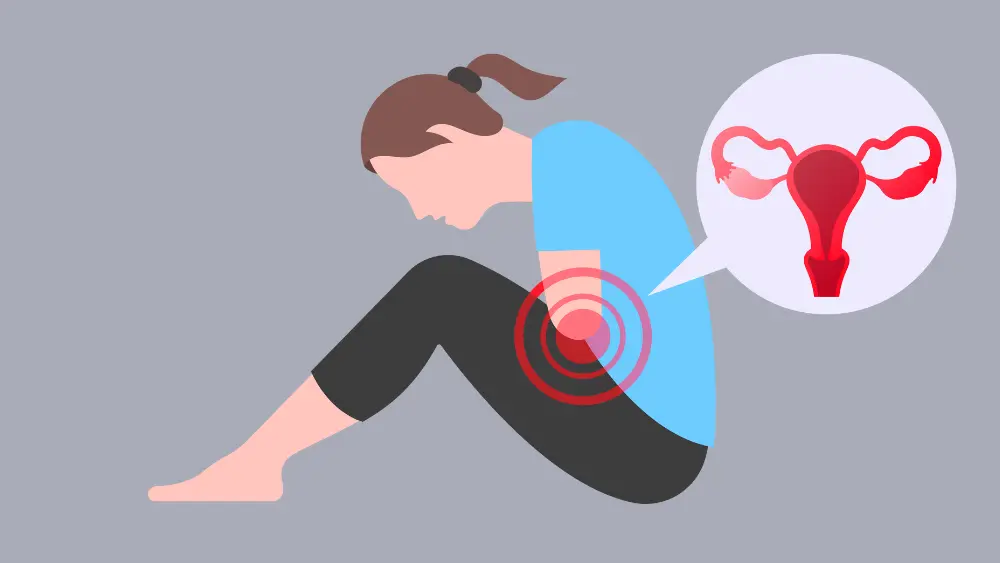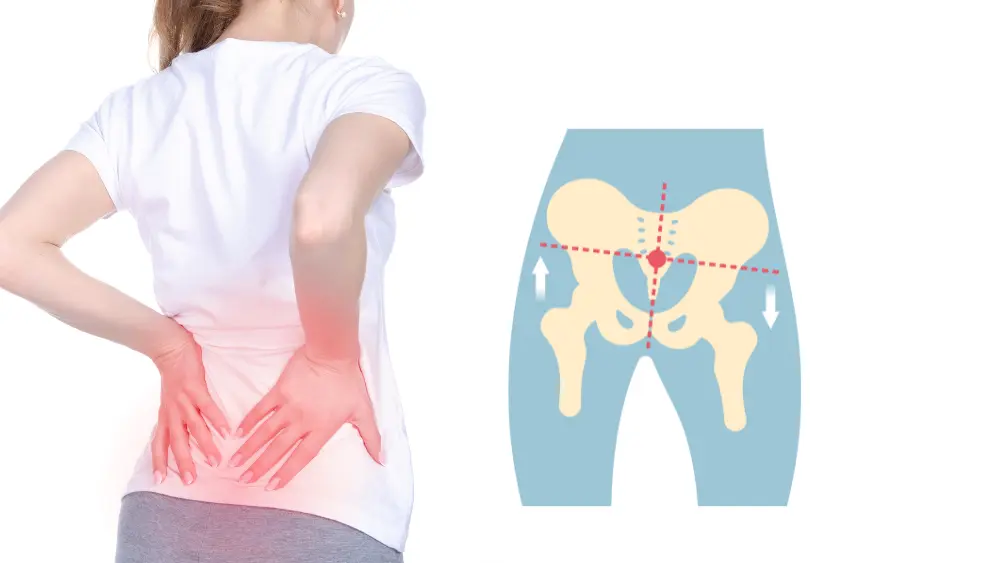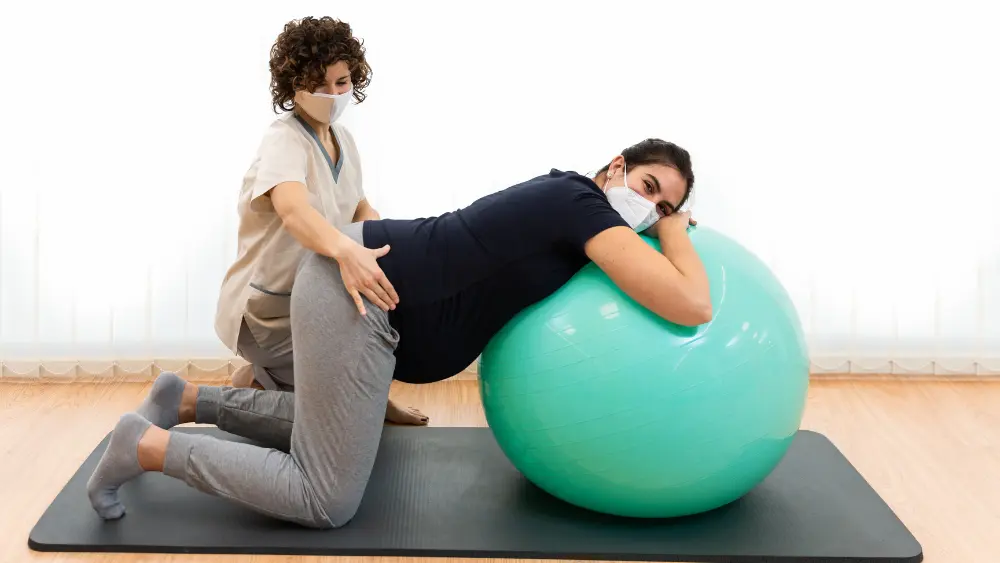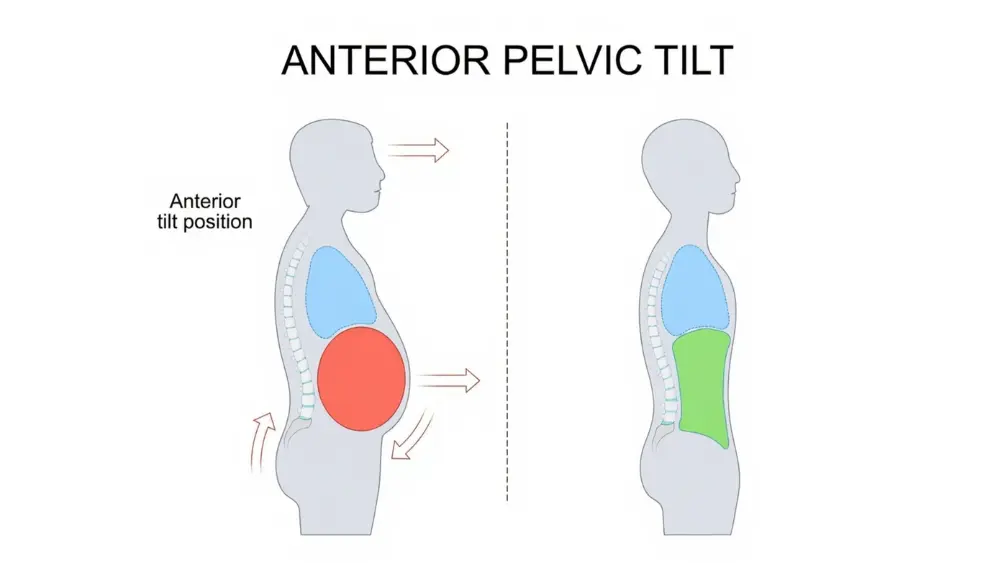By improving alignment, reducing discomfort, and stabilizing your pelvis, an anteriorelvic tilt brace can help you move with ease and confidence. These brace options are very helpful for expectant mothers who are looking for efficient relief from discomfort related to their posture. The best brace for anterior pelvic tilt is highlighted along with top brands with comprehensive features, complementary exercises, lifestyle advice, and emotional well-being strategies to ensure comfort and empowerment throughout your pregnancy journey. This comprehensive health resource written particularly to expectant mothers goes deep into causes, symptoms and management methods of the condition.
Table of Contents
- What Is Anterior Pelvic Tilt in Pregnancy?
- Hormonal Effects on Pelvic Alignment
- Benefits of an Anterior Pelvic Tilt Brace
- Selecting the Best Brace for Anterior Pelvic Tilt
- Top Anterior Pelvic Tilt Back Brace Options
- How to Wear an Anterior Pelvic Tilt Back Brace
- Integrating Brace for Anterior Pelvic Tilt into Daily Life
- Pregnancy-Safe Exercises for Anterior Pelvic Tilt
- Advanced Techniques: Synergizing Braces and Exercises
- Postpartum Recovery with Anterior Pelvic Tilt Brace
- Debunking Myths About Anterior Pelvic Tilt
- When to Consult a Medical Professional
- Nutrition to Support Pelvic Health
- Sleep Strategies to Ease Tilt Discomfort
- Emotional Well-Being During Pregnancy
- Preventing Anterior Pelvic Tilt in Future Pregnancies
- FAQ: Anterior Pelvic Tilt Brace During Pregnancy
What Is Anterior Pelvic Tilt in Pregnancy?
Anterior pelvic tilt occurs when the pelvis tilts forward, exaggerating the lower back’s arch. In pregnancy, the growing baby’s weight shifts your center of gravity, pulling the pelvis downward, often starting in the second trimester.
Causes:
- Increased abdominal weight from the fetus adds pressure to the pelvis.
- Relaxin hormone loosens pelvic ligaments for childbirth preparation.
- Pre-existing weak glutes or tight hip flexors from sedentary habits.
- Misuse of the body through sitting or standing for too long in a bad posture.
Symptoms:
- Chronic lower back pain or stiffness that is aggravated by activity.
- Hip discomfort, particularly when standing or walking.
- Protruding abdomen, impacting balance and posture.
- Sciatica or pelvic girdle pain (SPD), causing shooting leg pain.
Risks if Unmanaged: Potential sacroiliac joint dysfunction, lumbar strain, or chronic pain postpartum.
An anterior pelvic tilt brace stabilizes the pelvis, reducing pain and supporting better posture during pregnancy tasks like household chores or light exercise.
Hormonal Effects on Pelvic Alignment

The progesterone released in the process of pregnancy, relaxes the ligaments in anticipation of childbirth which may cause instability to the pelvis which further worsens anterior pelvic tilt. This occurs at its peak within the 12-36 weeks and there are still effects after birth.
Key Hormone: Relaxin increases joint laxity, affecting sacroiliac and pubic symphysis joints.
Risk Factors:
- Weak core or gluteal muscles, reducing pelvic support.
- Tight hip flexors from prolonged sitting or pre-pregnancy inactivity.
- Multiple pregnancies amplify pelvic stress and ligament laxity.
Management Tip: Pair an anterior pelvic tilt brace with core-strengthening exercises to counter hormonal effects and improve stability.
Benefits of an Anterior Pelvic Tilt Brace
An anterior pelvic tilt brace realigns the pelvis to a neutral position, easing strain on the lower back and hips. Pregnant women have to ensure that they will still be mobile and comfortable in their daily pursuits.
| Benefit | Description |
| Pain Relief | Distributes weight to lessen lumbar and hip strain. |
| Posture Support | Encourages neutral pelvic alignment for better balance and spinal health. |
| Enhanced Mobility | Supports walking, standing, and household tasks without discomfort. |
| Postpartum Recovery | Aids pelvic realignment post-delivery, reducing lingering tilt issues. |
| Sciatica Relief | Minimizes nerve compression, reducing leg pain and tingling. |
A brace for anterior pelvic tilt, as opposed to a standard maternity belt, applies precise, adjustable compression to the lumbar and sacroiliac regions for customized support.
Selecting the Best Brace for Anterior Pelvic Tilt

Adjustability, breathability, and pregnancy-specific design must all be considered when selecting the best brace for anterior pelvic tilt. All through the trimesters, medical-grade things ensure solace, solidness and protected utilizations.
| Brace Name | Key Features | Ideal Use Case | Price Range | User Rating |
| PlayActive Pelvic Support Belt | Adjustable straps, anti-slip nylon-neoprene blend, strong compression | General tilt relief, daily wear | $30-$50 | 4.5/5 |
| V-Sling Maternity Belt | Lightweight crisscross sling design, soft nylon, targeted support | Lightning crotch, SPD relief | $25-$40 | 4.7/5 |
| BraceAbility Pelvic Tilt Brace | Wide coverage, washable, durable Velcro, lumbar support | Rotated hips, sciatica support | $35-$55 | 4.3/5 |
| Belly Bandit V-Sling | Flexible neoprene, adjustable hook-and-loop, hypoallergenic | Pelvic girdle pain, vulvar varicosities | $30-$45 | 4.8/5 |
| Serola Sacroiliac Belt | Non-elastic layer for firm stability, breathable open-cell foam | SI joint dysfunction, postpartum recovery | $40-$60 | 4.6/5 |
| Motif Pregnancy Back Brace | Lumbar pad, professional design for months 3-9, reinforced stitching | Lower back pain, extended wear | $45-$65 | 4.4/5 |
| Azmed Maternity Belt | Breathable mesh, elastic straps, lightweight construction | General support, early pregnancy | $20-$35 | 4.2/5 |
| Gabrialla Maternity Belt | Cotton-lined, extra-wide support, adjustable Velcro | Moderate tilt, sensitive skin | $35-$50 | 4.5/5 |
- Choose adjustable straps to guarantee a fit for a bump that morphs as the trimester goes on.
- Choose hypoallergenic, breathable materials to prevent skin irritation during prolonged wear.
- Check for FSA/HSA eligibility to offset costs with health savings accounts.
Top Anterior Pelvic Tilt Back Brace Options
An anterior pelvic tilt back brace combines pelvic and lumbar support, countering the forward pull of your pregnant belly to promote a neutral spine and alleviate discomfort.
Top Brands:
- SueStar Sacroiliac Belt:Designed with a 3D pressure system, which includes a removable massage pad and targets SI joint relief, slipping-resistant silicone strips that guard secure fit, and breathable neoprene that allows it to be worn on a daily basis. Ideal for pregnant women with sciatica or moderate pelvic tilt pain, offering customizable compression.
- Ortorex Hip-Up Correction Belt: Incorporates memory cartilage for adaptive pelvic stability, breathable mesh fabric for ventilation, and a flexible design for active moms. Perfect for walking or light exercise, supporting dynamic movement without slipping.
- Posture Magic SI Belt: Discreet under clothing with a low-profile design, lightweight materials, and gentle compression for mild recovery exercises. Suitable for moms transitioning to postpartum recovery or those with minimal tilt symptoms.
- ChongErfei 3-in-1 Postpartum Belt: Multi-layer design with separate pelvic, waist, and abdominal panels for comprehensive support. Adjustable Velcro ensures a snug fit, making it ideal for both pregnancy and postpartum recovery, especially for severe tilt or C-section recovery.
- NeoTech Care Maternity Belt: Lightweight with double-layer Velcro for a customizable fit, breathable fabric, and a slim profile for early pregnancy support. Great for moms seeking minimal bulk during daily activities.
- Pelvic Clock Device: Not a brace but a complementary exercise tool with a contoured design to guide pelvic tilts, enhancing neutral alignment when paired with braces. Ideal for structured exercise routines.
- Wearing Tip: Use during active periods like chores or walks; avoid over-reliance to maintain natural muscle strength.
How to Wear an Anterior Pelvic Tilt Back Brace

- Positioning: Position low about the hips, just below the belly, so it provides snug but comfortable compression to support the sacroiliac joints.
- Usage Guidelines: Use for 2-6 hours during demanding activities as walking, cleansing, or standing.
- Resting: Take out during resting or sleeping to help engage core & pelvic muscles naturally.
- Fit Check: Use straps as needed to prevent pinching or restricted blood flow; the brace needs to lie flat against the skin.
- Doctor’s Advice: Consult a prenatal specialist for trimester-specific fitting, especially in late pregnancy when the bump is larger.
Integrating Brace for Anterior Pelvic Tilt into Daily Life
A brace will be beneficial to the routine and will add even more comfort to help improve on anterior pelvic tilt to assist in holding the upright posture throughout the pregnancy.
Morning Routine: Apply the brace before starting daily tasks to stabilize alignment during activities like preparing breakfast or getting dressed.
Work Environment:
- Use an ergonomic chair with lumbar support to complement the brace.
- Take 5-minute stretch breaks every 45-60 minutes to prevent stiffness.
Evening Routine: Take off the brace when resting; do some light stretching to loosen up the muscles and provide support of the pelvis position.
Complementary Lifestyle Adjustments
Nutrition: To maintain the fitness of the bones and muscles, a healthy diet that includes protein (lean meat, lentils, Greek yogurt) and calcium (dairy products, kale, not from concentrate orange juice).
Physical Activity: Enroll in prenatal yoga or swimming classes (1-2 sessions weekly) to strengthen core and gluteal muscles, reducing tilt severity.
Posture Habits:
- Stand with shoulders back, knees slightly bent, and weight evenly distributed.
- When long hours are spent sitting, slouching in a sitting position should be avoided by employing a lumbar pillow.
Pregnancy-Safe Exercises for Anterior Pelvic Tilt

Pair an anterior pelvic tilt brace with exercises to build long-term pelvic stability. Focus on gentle, pregnancy-safe movements tailored to your trimester.
| Exercise | Description | Reps/Time | Trimester Notes |
| Pelvic Tilts | Flatten lower back against a wall or floor (if comfortable) to engage core | 10-15 reps | Avoid lying flat in 3rd trimester; use standing variation |
| Cat-Cow Stretch | On all fours, arch and round spine to mobilize pelvis and reduce tension | 10 reps | Suitable for all trimesters; keep movements slow |
| Glute Bridges | Lie on back (early pregnancy) or incline, lift hips to engage glutes | 10-12 reps | Use pillows for support in late pregnancy to avoid discomfort |
| Seated Marching | Sit on a chair, lift knees alternately to engage core and hip flexors | 12 reps per side | Ideal for 2nd-3rd trimester; use firm chair |
- Safety Note: Discuss the movement of a prenatal trainer and adjust it to make it more comfortable and safe.
- Frequency: Do 10-15 minutes a day and wear the brace for extra support during training.
Advanced Techniques: Synergizing Braces and Exercises
Combine your anterior pelvic tilt brace with targeted exercises to optimize pelvic alignment and pain relief.
- Light Activity: Wear the brace during 20-30 minute walks to stabilize the pelvis and support posture.
- Bird-Dog Pose: On all fours, extend opposite arm and leg to build core stability (10 reps per side).
- Posterior Tilts: Post-brace removal, tilt pelvis backward to reinforce neutral position (10-12 reps).
- Progress Tracking: Check pain and movements once a week and tighten the brace according to comfort during the pregnancy.
Postpartum Recovery with Anterior Pelvic Tilt Brace
An anterior pelvic tilt brace is used after delivery to support pelvic alignment until the stabilizing hormones have time to work on alignment and until the muscles have recovered. It is adapted to persistent tilt and a weak core in particular.
Usage Plan
- Wear for about 4-8 weeks after childbirth and gradually decrease it to 1-2 hours per day when it gets stronger.
- Together with kegel exercises (10-15 reps, 3 times) to strengthen the muscles of the pelvic floor. Strengthen pelvic floor muscles.
Progress Indicators: Reduced back pain, improved posture, and easier movement during daily tasks.
Transition Strategy: Gradually shift to exercise-focused recovery as core and glute strength return.
Debunking Myths About Anterior Pelvic Tilt

Misconceptions can hinder effective management of anterior pelvic tilt during pregnancy.
| Myth | Reality |
| Tilt is permanent during pregnancy | Manageable with brace for anterior pelvic tilt and exercises; often resolves postpartum with consistent effort |
| Braces weaken pelvic muscles | Support muscle strengthening when used correctly, preventing over-reliance |
| Only severe cases benefit from braces | Even mild tilt improves with anterior pelvic tilt back brace, enhancing comfort and mobility |
- Key Takeaway: Long-term recovery is supported, and symptoms are considerably reduced with regular use of braces and specific exercises.
When to Consult a Medical Professional
Symphysis pubis dysfunction (SPD) or other pelvic problems may be indicated by persistent pain even after wearing an anterior pelvic tilt brace.
- Warning Signs:
- Severe pelvic or lower back pain that disrupts daily activities.
- Inability to walk, stand or climb without the assistance of other people.
- Nerve compression is indicated by persistent sciatica or numbness in the legs.
- Professional Support:
- Prenatal experts determine the position of the pelvis and prescribe suitable braces.
- There are special braces and exercise programs developed by physiotherapists designed to treat specific symptoms.
Nutrition to Support Pelvic Health

A nutrient-rich diet enhances muscle and ligament health, complementing your brace for anterior pelvic tilt for optimal pelvic stability.
| Nutrient | Sources | Benefit |
| Calcium | Dairy, kale, fortified orange juice | Strengthens pelvic bones and joints for better stability |
| Protein | Chicken, lentils, Greek yogurt | Supports muscle repair and growth, aiding core strength |
| Omega-3s | Salmon, walnuts, chia seeds | Reduces inflammation, easing pelvic and back pain |
| Vitamin D | Eggs, fortified cereals, sunlight exposure | Enhances calcium absorption for bone health |
- Hydration: Drink 10-12 glasses of water daily to maintain ligament flexibility and joint health.
- Anti-inflammatory Foods: Include berries, spinach, and turmeric in meals to reduce pain and swelling.
Sleep Strategies to Ease Tilt Discomfort
Correct spine sleep position reduces the strain caused by anterior pelvic tilt and enhances sleep.
- Optimal Position: Side-sleep with a firm pillow between knees to align hips and reduce pelvic pressure.
- Brace Use: Wear a light anterior pelvic tilt back brace overnight if discomfort persists, ensuring minimal bulk for sleep comfort.
- Positions to Avoid: The positions to be avoided: Back sleeping that worsens the lumbar arch and increases the degree of tilt.
- Bedtime Routine: Do 5-10 light pelvic tilts at bedtime to relax muscles and set up to rest.
Emotional Well-Being During Pregnancy
It is psychologically demanding to deal with anterior pelvic tilt when it is accompanied by physical discomfort. The prioritization of mental health helps contribute to wellness.
Mindfulness Practices:
- In order to reduce stress, we can recommend at least 5-10 minutes of daily practice of deep breathing or guided meditation to get more of that practice.
- Use a journal as a means to work through physical pain and feelings of pregnancy.
Support Networks:
- Join online forums or local mom groups to share the best braces for anterior pelvic tilt experiences and tips.
- Connect with friends, family, or doulas for brace recommendations and exercise advice.
Self-Care Tips: Schedule rest periods and gentle activities like prenatal massage or warm baths to alleviate tension.
Preventing Anterior Pelvic Tilt in Future Pregnancies
Learn new habits that are long-term to avoid a recurrence of anterior pelvic tilt during a future pregnancy or every day.
- Core Strength Maintenance:
- Keep doing pelvic tilts and prenatal yoga ( 2-3 times per week) to build core/glutes.
- Engage in low-impact activities like swimming or Pilates to maintain pelvic stability.
- Ergonomic Adjustments:
- Use supportive chairs with lumbar cushions to promote neutral spine alignment.
- Take standing breaks every 30 minutes during work to avoid prolonged sitting.
- Occasional Brace Use: Wear a back brace for anterior pelvic tilt during high-risk activities like heavy lifting or intense exercise.
FAQ: Anterior Pelvic Tilt Brace During Pregnancy
What is an anterior pelvic tilt brace?
A belt stabilizing the pelvis, reducing tilt pain.
Can I wear it all day?
Use 2-4 hours; consult a doctor.
Best brace for the third trimester?
V-Sling, PlayActive, Belly Bandit.
Does an anterior pelvic tilt back brace help postpartum?
Yes, with exercises.
Exercise frequency with a back brace for anterior pelvic tilt?
10 minutes daily.
Let’s explore more on Pregnancy Must –
- Maternity Support Belt for Pregnancy: Comfort & Relief
- Best Pregnancy and Maternity Pillow for Comfortable Sleep
- Feet Swelling Shoes: Step into Comfort, Beat Pain Behind
